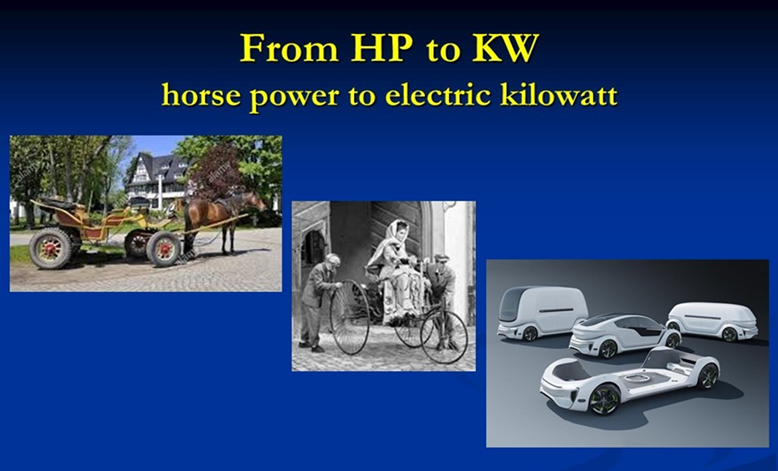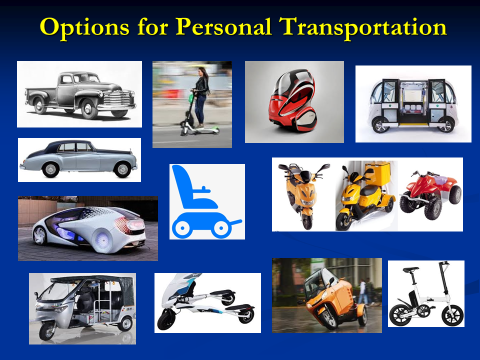
From Horse Power to Electric Power
– Musings of Dr. Jamie Hsu, 11.23.2019
These days, you can read many reports, articles, and research papers on the future of transportation and the arrival of autonomous driving. But most of the predictions and studies are based on technologies, which do not take into account much of the users’ perspectives or different mobility needs.
Historically, the transition from horse-drawn carriage to internal combustion engine happened gradually and took decades. All the early-day automobiles had the style of a carriage. Eventually, people’s lifestyles made sedans, station wagons, pickups, minivans, and SUVs popular for various uses. Along the way, all vehicles began to look alike due to the optimization for fuel economy, interior space, and safety.
Lately, the advent of electric drives, batteries, sensors, controls, chips, and algorithms has allowed the emergence of autonomous vehicles, connected vehicles, and electric cars. On top of that, digital networks, mobile devices, and new business models are transforming the user’s mobility experience and expectations.
If you are in the transportation industry, you should pay attention to a few major trends to prepare yourself and your business for the inevitable.
First, consumers are paying more attention to the availability and reliability of mobility than to the ownership of a particular vehicle. Ride-hailing, renting, leasing, and subscribing to vehicles will become better for satisfying people’s mobility needs. “Just in case” purchasing of a big vehicle will be replaced by “just in need” renting of the most relevant vehicles.
Second, people’s transportation needs are changing; elderly care, last-mile mobility from mass transit, rural area coverage, congested city streets, limited parking spaces, and other factors will cause people to use various 2,3, and 4 wheelers. We are even seeing youth using electric skateboards and scooters as their transportation tools.
The bottom line is this: Don’t assume future “vehicles” will look like today’s cars. The future mobility device has not been invented yet. Keep your eyes open and your mind ready to grab new possibilities.


從”馬”力、到”電”力
-作者 許俊宸博士
-中譯 薛乃綺
最近的日子,你可以讀到許多有關未來交通運輸及自動駕駛技術到來的新闻、文獻、研究報告。多數的預測以及研究都是基於技術的成熟度,然而這些技術並未考慮到多數使用者的觀點,以及对不同載具的需求。
從歷史來看,從馬車到內燃機的產生是逐步演進、而且耗費了數十年。早期的汽車都有馬車的風格。後來,人們的生活型態讓轎車、旅行車、皮卡、小貨車、以及SUV流行起來,廣泛地被使用。為了讓燃油效益、內部空間以及安全性得到提升优化,所有車輛開始變得相似。
近來,電子驅動器、電池、感測器、控制元件、晶片、以及人工演算法的產生,使得自動駕駛車、聯網車、電動車得以出現。更重要的是,數位網絡、移動設備與新的商業模式,正在改變消費者对 ’行与车’ 的經驗與期待。
若你是在運輸領域工作,需要注意一些主流趨勢,讓自己以及企業為不可避免的未來做好一些準備。
首先,比較起擁有一台車,消費者会更加關注移動載具的可用性與可靠性。叫車、租車、簽約車、預約車,都更能滿足人們移動的需求。為了”以防万一”所購買的大車,將會被”即時需要”的租賃相關車輛所取代。
其次,人們的交通需求正在改變。銀髮照護、公共交通的最後一哩路、偏遠地區、擁擠的都市街道、有限的停車位等因素,都將造成人們去使用更多種2、3輪或4輪車輛。我們甚至可以看到年輕人使用電動滑板車或電動踏板車作為他們的交通工具。
這就是最重要的信息。千萬別以為未來的”車輛”會長得跟現在的一樣。未來的移動載具甚至還沒出現呢,我們得张大眼睛,開放心態,更加關注掌握所有新的可能性。


